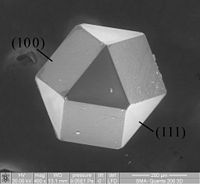
Photo from wikipedia
Abstract Metal surface nanocrystallization can improve the surface activity, reduce the diffusion activation energy, and then reduce the diffusion temperature or time. However, for gradient nanostructured surface layer on 32Cr2Mo1VE… Click to show full abstract
Abstract Metal surface nanocrystallization can improve the surface activity, reduce the diffusion activation energy, and then reduce the diffusion temperature or time. However, for gradient nanostructured surface layer on 32Cr2Mo1VE prepared by surface ultrasonic rolling process (SURP), the surface nanocrystallization seriously hindered the diffusion of N atoms during gas nitriding (430 °C, 480 °C and 530 °C). The effect of the distribution of alloying elements on the diffusion of active N atoms was studied in detail. For multi-element medium‑carbon alloy steels, it should be that carbides or nitrides formed by alloying elements usually precipitate easily at grain boundaries. So, precipitates along grain boundaries will block the rapid diffusion channel of nanocrystalline grain boundaries and also reduces the concentration gradient drive.
Journal Title: Materials Characterization
Year Published: 2021
Link to full text (if available)
Share on Social Media: Sign Up to like & get
recommendations!